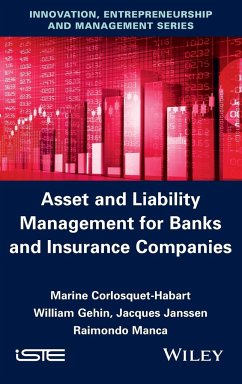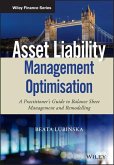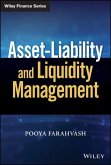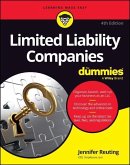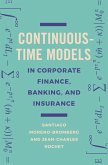Marine Corlosquet-Habart, William Gehin, Jacques Janssen
Asset and Liability Management for Banks and Insurance Companies
Marine Corlosquet-Habart, William Gehin, Jacques Janssen
Asset and Liability Management for Banks and Insurance Companies
- Gebundenes Buch
- Merkliste
- Auf die Merkliste
- Bewerten Bewerten
- Teilen
- Produkt teilen
- Produkterinnerung
- Produkterinnerung
This book introduces ALM in the context of banks and insurance companies. Although this strategy has a core of fundamental frameworks, models may vary between banks and insurance companies because of the different risks and goals involved.
Andere Kunden interessierten sich auch für
![Asset Liability Management Optimisation Asset Liability Management Optimisation]() Beata LubinskaAsset Liability Management Optimisation94,99 €
Beata LubinskaAsset Liability Management Optimisation94,99 €![The Changing Face of Corruption in the Asia Pacific The Changing Face of Corruption in the Asia Pacific]() Chris RowleyThe Changing Face of Corruption in the Asia Pacific175,99 €
Chris RowleyThe Changing Face of Corruption in the Asia Pacific175,99 €![Asset-Liability and Liquidity Management Asset-Liability and Liquidity Management]() Pooya FarahvashAsset-Liability and Liquidity Management50,99 €
Pooya FarahvashAsset-Liability and Liquidity Management50,99 €![Limited Liability Companies for Dummies Limited Liability Companies for Dummies]() Jennifer ReutingLimited Liability Companies for Dummies26,99 €
Jennifer ReutingLimited Liability Companies for Dummies26,99 €![Continuous-Time Models in Corporate Finance, Banking, and Insurance Continuous-Time Models in Corporate Finance, Banking, and Insurance]() Santiago Moreno-BrombergContinuous-Time Models in Corporate Finance, Banking, and Insurance63,99 €
Santiago Moreno-BrombergContinuous-Time Models in Corporate Finance, Banking, and Insurance63,99 €![Fundamentals of International Aviation Law and Policy Fundamentals of International Aviation Law and Policy]() Benjamyn I. ScottFundamentals of International Aviation Law and Policy86,99 €
Benjamyn I. ScottFundamentals of International Aviation Law and Policy86,99 €![Liability Insurance in International Arbitration Liability Insurance in International Arbitration]() Sir Richard Jacobs (UK English High Court)Liability Insurance in International Arbitration204,99 €
Sir Richard Jacobs (UK English High Court)Liability Insurance in International Arbitration204,99 €-
-
-
This book introduces ALM in the context of banks and insurance companies. Although this strategy has a core of fundamental frameworks, models may vary between banks and insurance companies because of the different risks and goals involved.
Hinweis: Dieser Artikel kann nur an eine deutsche Lieferadresse ausgeliefert werden.
Hinweis: Dieser Artikel kann nur an eine deutsche Lieferadresse ausgeliefert werden.
Produktdetails
- Produktdetails
- Verlag: ISTE Ltd and John Wiley & Sons Inc
- Seitenzahl: 176
- Erscheinungstermin: 21. September 2015
- Englisch
- Abmessung: 240mm x 161mm x 14mm
- Gewicht: 390g
- ISBN-13: 9781848218833
- ISBN-10: 1848218834
- Artikelnr.: 43162847
- Herstellerkennzeichnung
- Libri GmbH
- Europaallee 1
- 36244 Bad Hersfeld
- gpsr@libri.de
- Verlag: ISTE Ltd and John Wiley & Sons Inc
- Seitenzahl: 176
- Erscheinungstermin: 21. September 2015
- Englisch
- Abmessung: 240mm x 161mm x 14mm
- Gewicht: 390g
- ISBN-13: 9781848218833
- ISBN-10: 1848218834
- Artikelnr.: 43162847
- Herstellerkennzeichnung
- Libri GmbH
- Europaallee 1
- 36244 Bad Hersfeld
- gpsr@libri.de
Marine Corlosquet-Habart is a certified actuary and co-director of EURIA (Euro-Institut d'Actuariat, University of West Brittany, Brest, France). She teaches at EURIA, Telecom Bretagne and Ecole Centrale Paris (France). Her main research interests are pandemics, Solvency II internal models and ALM issues for insurance companies. William Gehin is a graduate engineer and actuary with risk management experience in both banking (Rothschild, HSBC) and insurance (BNP Paribas Cardif). His actuary dissertation concerned the management of extreme financial risks and received two international prizes (FFSA and AFGAP-PRMIA prize). Jacques Janssen is Honorary Professor at the Solvay Business School (ULB) in Brussels, Belgium, having previously taught at EURIA (Euro-Institut d'Actuariat, University of West Brittany, Brest, France) and Telecom Bretagne (Brest, France) as well as being a director of Jacan Insurance and Finance Services, a consultancy and training company. Raimondo Manca is Professor of mathematical methods applied to economics, finance and actuarial science at the University of Rome in Italy. His main research interests are multidimensional linear algebra, computational probability, the application of stochastic processes to economics, finance and insurance and simulation models.
INTRODUCTION ix
CHAPTER 1. DEFINITION OF ALM IN THE BANKING AND INSURANCE AREAS 1
1.1. Introduction 1
1.2. Brief history of ALM for banks and insurance companies 2
1.3. Missions of the ALM department 3
1.3.1. Missions of the ALM department for banks 3
1.3.2. Missions of the ALM department for insurance companies 5
1.4. Conclusion 8
CHAPTER 2. RISKS STUDIED IN ALM 9
2.1. Introduction 9
2.2. Risks studied in a bank in the framework of Basel II and III 9
2.2.1. Main risks for banks 9
2.2.2. From Basel I to Basel III 11
2.3. Stress tests 15
2.3.1. What is a stress test? 15
2.3.2. The stress tests of 2014 16
2.4. Risks studied in an insurance company in the framework of Solvency II
17
2.4.1. Solvency II in a nutshell 17
2.4.2. Focus on the risks 20
2.5. Commonalities and differences between banks and insurance companies'
problems 25
2.5.1. Commonalities 25
2.5.2. Differences 25
2.6. Conclusion 26
CHAPTER 3. DURATIONS (REVISITED) AND SCENARIOS FOR ALM 27
3.1. Introduction 27
3.2. Duration and convexity risk indicators 28
3.3. Scenario on the cash amounts of the flow 32
3.4. Scenario on the time maturities of the flow 34
3.5. Matching asset and liability 36
3.6. Matching with flow scenarios 40
3.7. ALM with the yield curve 43
3.7.1. Yield curve 43
3.7.2. ALM with the equivalent constant rate 44
3.8. Matching with two rates 46
3.9. Equity sensitivity 47
3.9.1. Presentation of the problem 47
3.9.2. Formalization of the problem 48
3.9.3. Time dynamic of asset and liability flows 49
3.9.4. Sensitivity of equities and VaR indicator 51
3.9.5. Duration of equities 52
3.9.6. Special case of the aggregated balance sheet 52
3.9.7. A VaR approach 54
3.10. ALM and management of the bank 58
3.10.1. Basic principles 58
3.10.2. ALM and shares 58
3.10.3. Stochastic duration 66
3.11. Duration of a portfolio 70
3.12. Conclusion 71
CHAPTER 4. BUILDING AND USE OF AN ALM INTERNAL MODEL IN INSURANCE COMPANIES
73
4.1. Introduction 73
4.2. Asset model 74
4.2.1. Equity portfolio 74
4.2.2. Bond portfolio 76
4.2.3. Real estate 82
4.2.4. Central scenario and simulated scenarios 83
4.3. Liability model 84
4.3.1. Model points 85
4.3.2. Mathematical reserves and annual policyholder benefits 87
4.3.3. Annual policyholder benefits and crediting rate 87
4.3.4. Profit sharing 90
4.3.5. Policyholder demography and behavior 91
4.3.6. Other reserves 94
4.3.7. Future new business 96
4.3.8. Fees and business costs 97
4.4. Structure of an ALM study 99
4.4.1. Determinist study 99
4.4.2. Stochastic study 103
4.5. Case study 105
4.5.1. Goal of the study 105
4.5.2. Business plan and other liability inputs 105
4.5.3. Central scenario and other asset inputs 106
4.5.4. Fee and cost hypotheses 107
4.5.5. Step-by-step model 107
4.5.6. The ALM study 109
4.6. Conclusion 114
CHAPTER 5. BUILDING AND USE OF ALM INTERNAL MODELS IN BANKS 115
5.1. Introduction 115
5.2. Case 1: Reduction of gaps 115
5.2.1. Basic numerical data 115
5.2.2. Basic ALM indicators 118
5.2.3. Scenario for loss reduction 119
5.3. Case 2: A stochastic internal model 121
5.3.1. Probability of bankruptcy 121
5.3.2. Presentation of the first model (Model I) 122
5.3.3. Presentation of the model with correlations (Model Ibis) 124
5.3.4. Presentation of the model with correlations and non-negative values
for assets and liabilities (Model II)126
5.3.5. Consequences for ALM 131
5.4. Calibration of the models 135
5.4.1. Historical method 135
5.4.2. Scenario generator 139
5.5. Example 139
5.5.1. Model Ibis 139
5.5.2. ALM II 142
5.6. Key points for building internal models 146
5.6.1. How to present an internal model? 146
5.6.2. Validation of the model 147
5.6.3. Partial and global internal models 147
5.7. Conclusion 148
CONCLUSION 149
BIBLIOGRAPHY 151
INDEX 153
CHAPTER 1. DEFINITION OF ALM IN THE BANKING AND INSURANCE AREAS 1
1.1. Introduction 1
1.2. Brief history of ALM for banks and insurance companies 2
1.3. Missions of the ALM department 3
1.3.1. Missions of the ALM department for banks 3
1.3.2. Missions of the ALM department for insurance companies 5
1.4. Conclusion 8
CHAPTER 2. RISKS STUDIED IN ALM 9
2.1. Introduction 9
2.2. Risks studied in a bank in the framework of Basel II and III 9
2.2.1. Main risks for banks 9
2.2.2. From Basel I to Basel III 11
2.3. Stress tests 15
2.3.1. What is a stress test? 15
2.3.2. The stress tests of 2014 16
2.4. Risks studied in an insurance company in the framework of Solvency II
17
2.4.1. Solvency II in a nutshell 17
2.4.2. Focus on the risks 20
2.5. Commonalities and differences between banks and insurance companies'
problems 25
2.5.1. Commonalities 25
2.5.2. Differences 25
2.6. Conclusion 26
CHAPTER 3. DURATIONS (REVISITED) AND SCENARIOS FOR ALM 27
3.1. Introduction 27
3.2. Duration and convexity risk indicators 28
3.3. Scenario on the cash amounts of the flow 32
3.4. Scenario on the time maturities of the flow 34
3.5. Matching asset and liability 36
3.6. Matching with flow scenarios 40
3.7. ALM with the yield curve 43
3.7.1. Yield curve 43
3.7.2. ALM with the equivalent constant rate 44
3.8. Matching with two rates 46
3.9. Equity sensitivity 47
3.9.1. Presentation of the problem 47
3.9.2. Formalization of the problem 48
3.9.3. Time dynamic of asset and liability flows 49
3.9.4. Sensitivity of equities and VaR indicator 51
3.9.5. Duration of equities 52
3.9.6. Special case of the aggregated balance sheet 52
3.9.7. A VaR approach 54
3.10. ALM and management of the bank 58
3.10.1. Basic principles 58
3.10.2. ALM and shares 58
3.10.3. Stochastic duration 66
3.11. Duration of a portfolio 70
3.12. Conclusion 71
CHAPTER 4. BUILDING AND USE OF AN ALM INTERNAL MODEL IN INSURANCE COMPANIES
73
4.1. Introduction 73
4.2. Asset model 74
4.2.1. Equity portfolio 74
4.2.2. Bond portfolio 76
4.2.3. Real estate 82
4.2.4. Central scenario and simulated scenarios 83
4.3. Liability model 84
4.3.1. Model points 85
4.3.2. Mathematical reserves and annual policyholder benefits 87
4.3.3. Annual policyholder benefits and crediting rate 87
4.3.4. Profit sharing 90
4.3.5. Policyholder demography and behavior 91
4.3.6. Other reserves 94
4.3.7. Future new business 96
4.3.8. Fees and business costs 97
4.4. Structure of an ALM study 99
4.4.1. Determinist study 99
4.4.2. Stochastic study 103
4.5. Case study 105
4.5.1. Goal of the study 105
4.5.2. Business plan and other liability inputs 105
4.5.3. Central scenario and other asset inputs 106
4.5.4. Fee and cost hypotheses 107
4.5.5. Step-by-step model 107
4.5.6. The ALM study 109
4.6. Conclusion 114
CHAPTER 5. BUILDING AND USE OF ALM INTERNAL MODELS IN BANKS 115
5.1. Introduction 115
5.2. Case 1: Reduction of gaps 115
5.2.1. Basic numerical data 115
5.2.2. Basic ALM indicators 118
5.2.3. Scenario for loss reduction 119
5.3. Case 2: A stochastic internal model 121
5.3.1. Probability of bankruptcy 121
5.3.2. Presentation of the first model (Model I) 122
5.3.3. Presentation of the model with correlations (Model Ibis) 124
5.3.4. Presentation of the model with correlations and non-negative values
for assets and liabilities (Model II)126
5.3.5. Consequences for ALM 131
5.4. Calibration of the models 135
5.4.1. Historical method 135
5.4.2. Scenario generator 139
5.5. Example 139
5.5.1. Model Ibis 139
5.5.2. ALM II 142
5.6. Key points for building internal models 146
5.6.1. How to present an internal model? 146
5.6.2. Validation of the model 147
5.6.3. Partial and global internal models 147
5.7. Conclusion 148
CONCLUSION 149
BIBLIOGRAPHY 151
INDEX 153
INTRODUCTION ix
CHAPTER 1. DEFINITION OF ALM IN THE BANKING AND INSURANCE AREAS 1
1.1. Introduction 1
1.2. Brief history of ALM for banks and insurance companies 2
1.3. Missions of the ALM department 3
1.3.1. Missions of the ALM department for banks 3
1.3.2. Missions of the ALM department for insurance companies 5
1.4. Conclusion 8
CHAPTER 2. RISKS STUDIED IN ALM 9
2.1. Introduction 9
2.2. Risks studied in a bank in the framework of Basel II and III 9
2.2.1. Main risks for banks 9
2.2.2. From Basel I to Basel III 11
2.3. Stress tests 15
2.3.1. What is a stress test? 15
2.3.2. The stress tests of 2014 16
2.4. Risks studied in an insurance company in the framework of Solvency II
17
2.4.1. Solvency II in a nutshell 17
2.4.2. Focus on the risks 20
2.5. Commonalities and differences between banks and insurance companies'
problems 25
2.5.1. Commonalities 25
2.5.2. Differences 25
2.6. Conclusion 26
CHAPTER 3. DURATIONS (REVISITED) AND SCENARIOS FOR ALM 27
3.1. Introduction 27
3.2. Duration and convexity risk indicators 28
3.3. Scenario on the cash amounts of the flow 32
3.4. Scenario on the time maturities of the flow 34
3.5. Matching asset and liability 36
3.6. Matching with flow scenarios 40
3.7. ALM with the yield curve 43
3.7.1. Yield curve 43
3.7.2. ALM with the equivalent constant rate 44
3.8. Matching with two rates 46
3.9. Equity sensitivity 47
3.9.1. Presentation of the problem 47
3.9.2. Formalization of the problem 48
3.9.3. Time dynamic of asset and liability flows 49
3.9.4. Sensitivity of equities and VaR indicator 51
3.9.5. Duration of equities 52
3.9.6. Special case of the aggregated balance sheet 52
3.9.7. A VaR approach 54
3.10. ALM and management of the bank 58
3.10.1. Basic principles 58
3.10.2. ALM and shares 58
3.10.3. Stochastic duration 66
3.11. Duration of a portfolio 70
3.12. Conclusion 71
CHAPTER 4. BUILDING AND USE OF AN ALM INTERNAL MODEL IN INSURANCE COMPANIES
73
4.1. Introduction 73
4.2. Asset model 74
4.2.1. Equity portfolio 74
4.2.2. Bond portfolio 76
4.2.3. Real estate 82
4.2.4. Central scenario and simulated scenarios 83
4.3. Liability model 84
4.3.1. Model points 85
4.3.2. Mathematical reserves and annual policyholder benefits 87
4.3.3. Annual policyholder benefits and crediting rate 87
4.3.4. Profit sharing 90
4.3.5. Policyholder demography and behavior 91
4.3.6. Other reserves 94
4.3.7. Future new business 96
4.3.8. Fees and business costs 97
4.4. Structure of an ALM study 99
4.4.1. Determinist study 99
4.4.2. Stochastic study 103
4.5. Case study 105
4.5.1. Goal of the study 105
4.5.2. Business plan and other liability inputs 105
4.5.3. Central scenario and other asset inputs 106
4.5.4. Fee and cost hypotheses 107
4.5.5. Step-by-step model 107
4.5.6. The ALM study 109
4.6. Conclusion 114
CHAPTER 5. BUILDING AND USE OF ALM INTERNAL MODELS IN BANKS 115
5.1. Introduction 115
5.2. Case 1: Reduction of gaps 115
5.2.1. Basic numerical data 115
5.2.2. Basic ALM indicators 118
5.2.3. Scenario for loss reduction 119
5.3. Case 2: A stochastic internal model 121
5.3.1. Probability of bankruptcy 121
5.3.2. Presentation of the first model (Model I) 122
5.3.3. Presentation of the model with correlations (Model Ibis) 124
5.3.4. Presentation of the model with correlations and non-negative values
for assets and liabilities (Model II)126
5.3.5. Consequences for ALM 131
5.4. Calibration of the models 135
5.4.1. Historical method 135
5.4.2. Scenario generator 139
5.5. Example 139
5.5.1. Model Ibis 139
5.5.2. ALM II 142
5.6. Key points for building internal models 146
5.6.1. How to present an internal model? 146
5.6.2. Validation of the model 147
5.6.3. Partial and global internal models 147
5.7. Conclusion 148
CONCLUSION 149
BIBLIOGRAPHY 151
INDEX 153
CHAPTER 1. DEFINITION OF ALM IN THE BANKING AND INSURANCE AREAS 1
1.1. Introduction 1
1.2. Brief history of ALM for banks and insurance companies 2
1.3. Missions of the ALM department 3
1.3.1. Missions of the ALM department for banks 3
1.3.2. Missions of the ALM department for insurance companies 5
1.4. Conclusion 8
CHAPTER 2. RISKS STUDIED IN ALM 9
2.1. Introduction 9
2.2. Risks studied in a bank in the framework of Basel II and III 9
2.2.1. Main risks for banks 9
2.2.2. From Basel I to Basel III 11
2.3. Stress tests 15
2.3.1. What is a stress test? 15
2.3.2. The stress tests of 2014 16
2.4. Risks studied in an insurance company in the framework of Solvency II
17
2.4.1. Solvency II in a nutshell 17
2.4.2. Focus on the risks 20
2.5. Commonalities and differences between banks and insurance companies'
problems 25
2.5.1. Commonalities 25
2.5.2. Differences 25
2.6. Conclusion 26
CHAPTER 3. DURATIONS (REVISITED) AND SCENARIOS FOR ALM 27
3.1. Introduction 27
3.2. Duration and convexity risk indicators 28
3.3. Scenario on the cash amounts of the flow 32
3.4. Scenario on the time maturities of the flow 34
3.5. Matching asset and liability 36
3.6. Matching with flow scenarios 40
3.7. ALM with the yield curve 43
3.7.1. Yield curve 43
3.7.2. ALM with the equivalent constant rate 44
3.8. Matching with two rates 46
3.9. Equity sensitivity 47
3.9.1. Presentation of the problem 47
3.9.2. Formalization of the problem 48
3.9.3. Time dynamic of asset and liability flows 49
3.9.4. Sensitivity of equities and VaR indicator 51
3.9.5. Duration of equities 52
3.9.6. Special case of the aggregated balance sheet 52
3.9.7. A VaR approach 54
3.10. ALM and management of the bank 58
3.10.1. Basic principles 58
3.10.2. ALM and shares 58
3.10.3. Stochastic duration 66
3.11. Duration of a portfolio 70
3.12. Conclusion 71
CHAPTER 4. BUILDING AND USE OF AN ALM INTERNAL MODEL IN INSURANCE COMPANIES
73
4.1. Introduction 73
4.2. Asset model 74
4.2.1. Equity portfolio 74
4.2.2. Bond portfolio 76
4.2.3. Real estate 82
4.2.4. Central scenario and simulated scenarios 83
4.3. Liability model 84
4.3.1. Model points 85
4.3.2. Mathematical reserves and annual policyholder benefits 87
4.3.3. Annual policyholder benefits and crediting rate 87
4.3.4. Profit sharing 90
4.3.5. Policyholder demography and behavior 91
4.3.6. Other reserves 94
4.3.7. Future new business 96
4.3.8. Fees and business costs 97
4.4. Structure of an ALM study 99
4.4.1. Determinist study 99
4.4.2. Stochastic study 103
4.5. Case study 105
4.5.1. Goal of the study 105
4.5.2. Business plan and other liability inputs 105
4.5.3. Central scenario and other asset inputs 106
4.5.4. Fee and cost hypotheses 107
4.5.5. Step-by-step model 107
4.5.6. The ALM study 109
4.6. Conclusion 114
CHAPTER 5. BUILDING AND USE OF ALM INTERNAL MODELS IN BANKS 115
5.1. Introduction 115
5.2. Case 1: Reduction of gaps 115
5.2.1. Basic numerical data 115
5.2.2. Basic ALM indicators 118
5.2.3. Scenario for loss reduction 119
5.3. Case 2: A stochastic internal model 121
5.3.1. Probability of bankruptcy 121
5.3.2. Presentation of the first model (Model I) 122
5.3.3. Presentation of the model with correlations (Model Ibis) 124
5.3.4. Presentation of the model with correlations and non-negative values
for assets and liabilities (Model II)126
5.3.5. Consequences for ALM 131
5.4. Calibration of the models 135
5.4.1. Historical method 135
5.4.2. Scenario generator 139
5.5. Example 139
5.5.1. Model Ibis 139
5.5.2. ALM II 142
5.6. Key points for building internal models 146
5.6.1. How to present an internal model? 146
5.6.2. Validation of the model 147
5.6.3. Partial and global internal models 147
5.7. Conclusion 148
CONCLUSION 149
BIBLIOGRAPHY 151
INDEX 153

